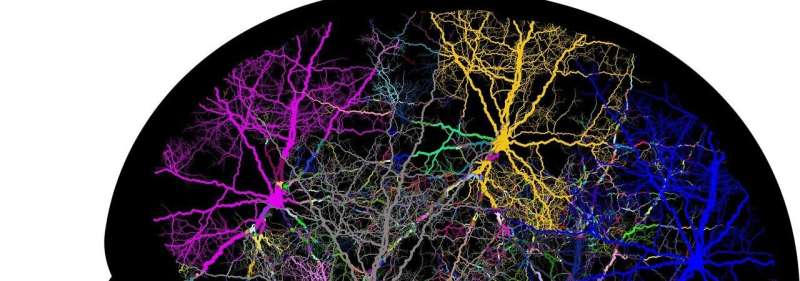
Environmental enrichment—with infrastructure, unfamiliar odors and tastes, and toys and puzzles—is often used in zoos, laboratories, and farms to stimulate animals and increase their wellbeing. Stimulating environments are better for mental health and cognition because they boost the growth and function of neurons and their connections, the glia cells that support and feed neurons, and blood vessels within the brain. But what are the deeper molecular mechanisms that first set in motion these large changes in neurophysiology? That’s the subject of a recent study in Frontiers in Molecular Neuroscience.
Here, a multinational team of scientists used a large molecular toolbox to map, in unprecedented detail, how environmental enrichment leads to changes in the 3D organization of chromosomes in neurons and glia cells of the mouse brain, resulting in the activation or deactivation of a minority of genes within the genome. They show that genes which in humans are important for cognitive mental health are especially affected. This finding could inspire the search for novel therapies.
Enrichment first causes the 3D structure of chromosomes to ‘open up’
“Here we show for the first time, with large-scale data from many state-of-the-art methods, that young adolescent mice that grew up in an extra stimulating environment have highly specific ‘epigenetic’ changes—that is, molecular changes other than in DNA sequence—to the chromosomes within the cells of the brain cortex,” says corresponding author Dr. Sergio Espeso-Gil from the Center for Genomic Regulation in Barcelona, Spain.
He continues, “These increase the local ‘openness’ and ‘loopiness’ of the chromosomes, especially around DNA stretches called enhancers and insulators, which then fine-tune more ‘downstream’ genes. This happens not only in neurons but also in the supportive glia cells, too often ignored in studies about learning.”
Espeso-Gil and colleagues raised laboratory mice for the first month after birth in social groups inside housing with Lego blocks, ladders, balls, and tunnels that were frequently changed and moved around. As a control, mice were raised in smaller groups inside standard housing. The authors then used a swath of complementary tools to look for molecular changes in neurons and glia cells within the brain cortex. These included changes in the 3D structure of chromosomes, in particular the local “chromatin accessibility” (openness) and “chromatin interactions” (where distant genes are brought together through loops, to coordinate activity).
Epigenetic ‘master’ switches
They show that one “master” switch operational after environmental enrichment is a locally increased activity of the protein CTCF, which stimulates chromatin interactions within and between chromosomes. A second master switch works by locally increasing chromatin accessibility, especially within the pyramidal neurons that are important for cognition. A third is the highly localized adding of CH3- (methyl) groups to the important chromosomal protein histone H3, a change which activates nearby genes.
These switches mainly occur around genomic regions that contain enhancers, regulatory DNA that (when bound to proteins called transcription factors) can activate neighboring genes. Also affected were genomic regions with insulators, regulatory DNA that can override the gene-activating effect of neighboring enhancers.
The authors conclude that growing up in an enriched environment causes highly local and specific epigenetic changes in neurons and glia cells. These then change the activity—predominantly by activation rather than inhibition—of a minority of genes within the genome. Overall, 0.2-0.4% of all enhancers and 2-5% of all promoters (i.e. start sites for the first step of gene expression, where DNA is transcribed into protein-coding or regulatory RNA) are affected.
Link to mental health in humans
“Our results show that many of the genes involved are known to play a role in the growth and differentiation of neurons, the development of blood vessels, the formation and patterning of new synaptic connections on neurons, and molecular pathways implicated in memory and learning in mice,” says Espeso-Gil.
Source: Read Full Article
